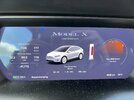"150 kW" V2 stalls have chargers that are arranged in four groups of three 12 kW charging units each. Full power is 144 kW, half power is 72 kW, and one quarter power is 36 kW.
In the past, the second vehicle to arrive at a pair would only get one group of chargers, for 36 kW max until the first vehicle's charge rate dropped below 72 kW, then both cars would each get two groups of chargers, for 72 kW each.
That has since changed (as of two years ago?), and the power is evenly split as soon as the second vehicle plugs in. When the first vehicle drops below 36 kW, the second vehicle will be allocated up to 108 kW.
Note that these are nominal figures that don't take into account battery heating. If your car is heating the battery or using climate control, you could see up to 10 kW less. You could also see less power if some of the chargers in the group that you're using aren't outputting at full capacity. For example, if one of the 12 chargers in the cabinet is malfunctioning, one of the cars will get 12 kW less than nominal. If your car is using 4 kW for climate control and there is one bad charger assigned to you, that would put you at 58 kW.
TL;DR the system is functioning as designed and you aren't being treated differently because you have free unlimited supercharging.



